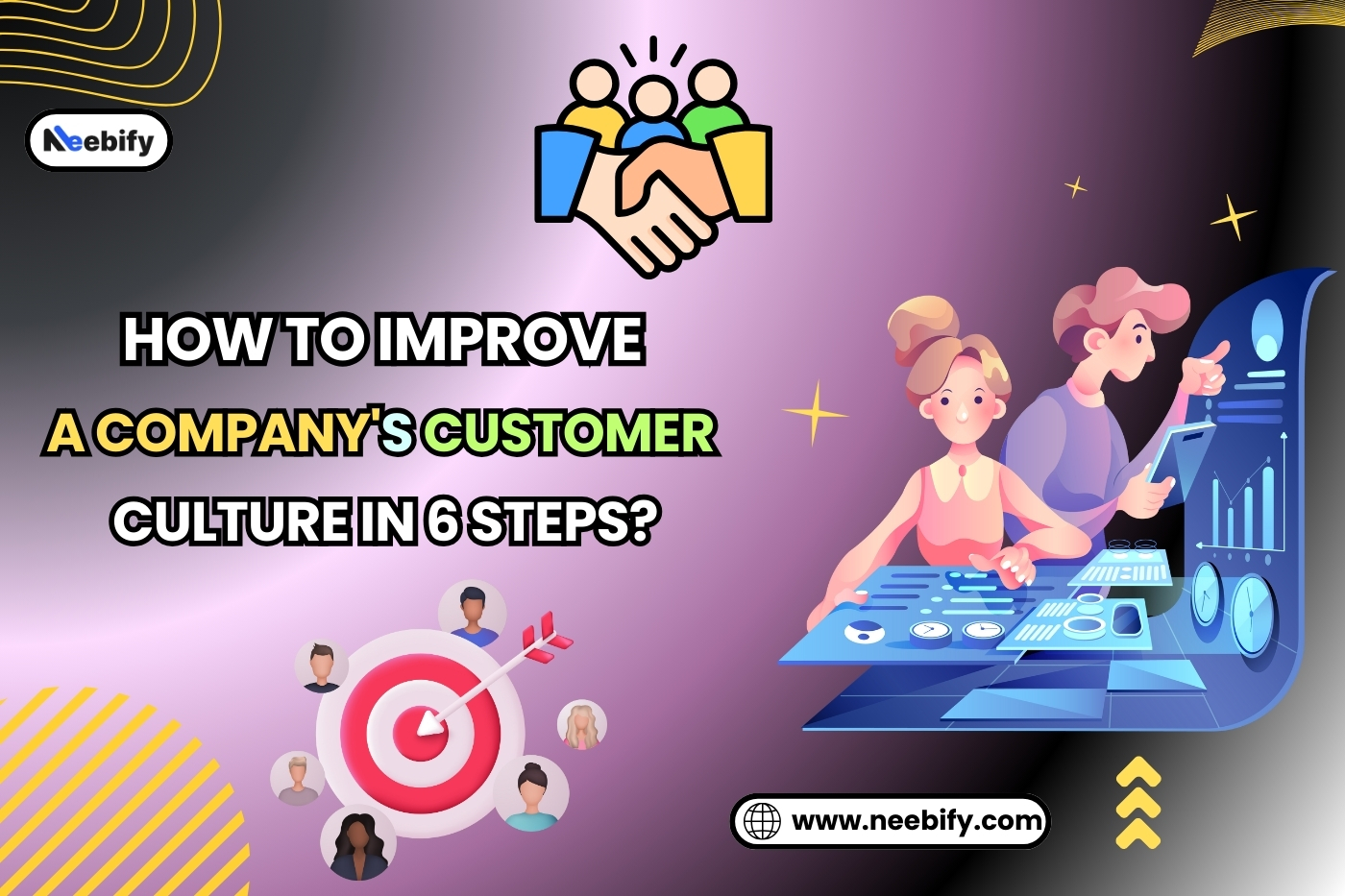Table of content
How to Improve a Company's Customer Culture in 6 Step?
Exceptional customer service and a great customer experience are what make or break any business in today's competitive marketplace. However, one of the most impactful ways of achieving these is by improving a company's customer culture. What does that mean, though, and how can businesses create and sustain a culture that places the customer first? This paper explores how the improvement of the customer service culture in your business will determine the successful development of a customer-centered organization and sustained businesses growth through customer culture.
What is Customer-Centric Culture?
An organization's mindset in being a customer-centric culture is one in which all its actions, decisions, and strategies are geared toward ensuring the best experience possible for the customer. It calls for aligning all departments-be it sales, marketing, or support-to one ultimate goal: meeting customers' needs and exceeding their expectations. A customer-centric company puts the customer at the center of everything; each employee is aware of his role in enhancing customer relations and satisfaction.
A customer-first company culture places the customer at the top of everything, and everything—every product, every service, every interaction—is done to ensure value for the customer. This alone helps in improving customer loyalty but drives long-term business success.
Four Pillars of Customer-Centric Culture
Before discussing the steps involved in developing a customer-oriented organization, it is necessary to know the four key pillars that define a customer-oriented culture:
1. Customer Understanding: This is the understanding of what your customers need, pain points, preferences, and behavior to create a tailored customer experience. A business should gather customer feedback regularly, conduct surveys, and analyze data to keep in tune with its target audience.
2. Employee Empowerment: All levels of employees must be empowered to make customer-centric decisions. If staff feel they have the tools, training, and authority to make decisions, they are likely to provide excellent service that leads to customer satisfaction.
3. Continuous Improvement: Building a culture of constant improvement means always looking for ways to enhance customer service and experience. Whether through training, feedback loops, or process adjustments, the business must be committed to evolving based on customer needs.
4. Aligned Values: For a company to fully embody a customer-oriented culture, the values of the organization have to be aligned with customer-centric objectives. Leadership has to model and communicate the values so that it can be instilled in the whole organization.
How to Build a Consistent Customer-Centric Culture Benefits a Business in 6 Steps?
Cultural improvement in the customer service sector involves change at multiple levels within an organization. Steps to improve customer service and drives consistent customer-centric culture can include the following:
1. Vision and Strategy for Customer Culture: A proper first step in building a customer-centric culture is the development of a clear vision and strategy, which must reflect business commitments to satisfying customers. Therefore, the leadership at companies should develop the reasons why a customer culture needs to be built and determine what company customer culture strategies to implement to help meet such visions. This should involve formulating long-term goals and identification of KPIs as monitors of the degree to which the goal is reached.
Let's start with some questions:
- What values do we want to put forward in our relationships with customers?
- How do we want our customers to see us?
- What kind of relationships do we want to have with our customers?
This vision should guide everything from the customer service policies of the business to the way employees talk to and interact with clients. All team members must understand the importance of customer relations improvement and exactly how they contribute toward the transformation of the company's customer culture.
2. Include Customer-Centric Leadership: The role of leadership in creating a customer-focused organization cannot be underestimated. Management and executive leadership should champion not only customer service excellence but lead by example. Employee training for customer service excellence is part of the on-boarding process and ongoing development. Leaders must actively communicate that customer service is essential and encourage employees to own the customer relationship.
When the customer-first values from top down are inculcated, then a clear tone is set with your employees. When customer-centric behaviors of leaders appear frequently, the staff imitates them. This again becomes a good ripple for the entire organization. As a result, employee morale improves and facilitates enriching customer experience at all touchpoints.
3. Enable Employees to Provide World-Class Service: Perhaps the best customer culture improvement tips are those that enable employees to make decisions for customers. Building a customer-driven culture means providing employees with the resources, skills, and authority to handle customer questions, solve customer problems, and make customer-focused decisions without having to seek managerial approval for each step of the process.
Employees should be equipped with appropriate training and resources so that they feel empowered to carry out their jobs. Empowerment results in quicker resolution of problems, better service delivery, and overall experience for the customer. The companies can boost customer loyalty through culture by making the employees act in the best interest of the customer and thereby improving overall satisfaction.
4. Invest in Customer Experience Tools and Technology: To improve customer service culture, one should invest in the right tools and technologies that streamline interactions with customers and provide personalized experiences. For instance, customer relationship management (CRM) software allows employees to track interactions and preferences with customers and ensures that every touch point is meaningful and relevant.
Also, incorporation of AI-based chatbots or automated support systems may enable speedy resolutions to frequent customer complaints. In other words, it helps with rapid responses and increases customer satisfaction levels. These technologies will need to supplement, rather than replace, the personal connection; otherwise, human empathy remains very important for creating long-lasting impressions.
5. Listen to and Act on Customer Feedback: Gathering and acting on customer feedback regularly is the foundation of how to develop a strong customer culture. This involves seeking customer opinions through surveys, reviews, and direct feedback in order to identify what is working and where there is room for improvement.
Customer satisfaction culture relies heavily on understanding pain points and making improvements that address customer needs. When businesses listen to their customers and act on feedback, it shows that the company values their opinions, which in turn increases customer trust and loyalty.
Moreover, keeping an open channel for feedback not only helps improve services but also strengthens customer relationships, as customers feel heard and valued.
6. Measure, Track, and Celebrate Success: Finally, businesses need to regularly measure the impact of their business customer culture transformation efforts. Tracking metrics like Net Promoter Score (NPS), customer retention rates, and customer satisfaction surveys will give you concrete data to understand how well you're performing in terms of your customer culture.
Don't forget to celebrate milestones and successes with your team. Rewarding employees who go above and beyond to deliver outstanding customer service will motivate others to follow in their footsteps. Once your team realizes that customer-first company culture is rewarded, they will be more likely to continue supporting it.
Conclusion
Building a customer-centric culture within your business is an ongoing process, effort, and commitment. The following 6 steps can be followed to improve customer service culture within an organization, which will eventually create a customer experience and then a relationship that will last for long. It's all about creating an environment where employees are empowered to deliver exceptional service, listening to customer feedback, and continually striving for improvement.
Remember, building a customer-focus organization isn't a one-time task but a continuous journey. By creating a culture that values the customer at its core, your company will not only stand out from competitors but will also see significant growth in customer loyalty, satisfaction, and overall business performance.
Get your next meeting in a
matter of minutes.
Free Trial
Latest
The Ultimate LinkedIn Outreach Playbook 2025
A practical, modern guide to mastering LinkedIn outreach in 2025 — learn how to boost reply rates, p
12/1/2025How to Find 100 ICP Leads Without LinkedIn Sales Navigator
Generating 100 targeted ICP leads doesn’t require LinkedIn Sales Navigator. Learn how to leverage fr
11/28/2025


